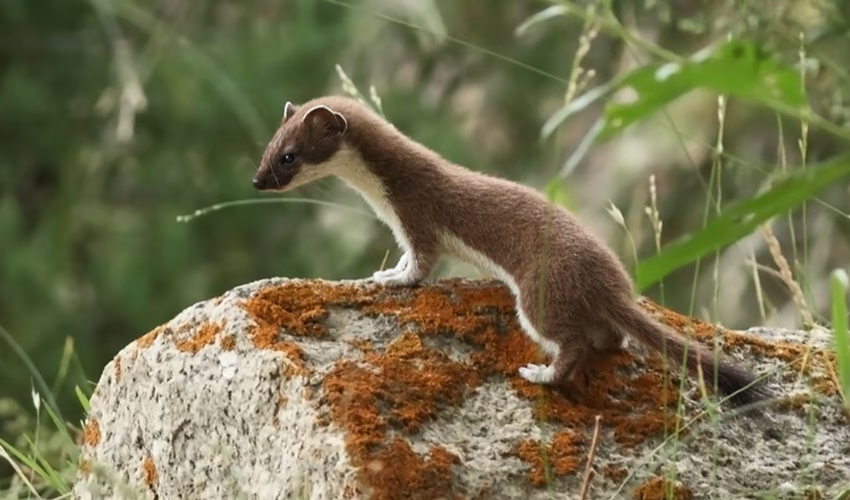langerhanscellhistiocytosis.org – The stoat (Mustela erminea), also known as the ermine, is a small, carnivorous mammal that belongs to the mustelid family. Known for its agility, sharp hunting skills, and remarkable coat color change in winter, the stoat is an impressive creature that plays a crucial role in its ecosystem. In this article, we will delve into the stoat’s physical characteristics, behavior, and its importance in nature.
1. What is a Stoat?
The stoat is a member of the Mustela genus, closely related to other mustelids like weasels, minks, and ferrets. This small mammal is widely distributed across the northern hemisphere, with populations found in parts of North America, Europe, and Asia. Despite its petite size, the stoat is a formidable predator known for its tenacity and agility.
2. Physical Characteristics of the Stoat
Stoats are small animals with elongated bodies, short legs, and a slender, flexible form that allows them to navigate through dense underbrush and chase prey into burrows. They typically measure around 12 to 20 inches long, including their tail, which can be about 5 to 8 inches. Stoats have distinctive fur, which is brown during the warmer months, with a creamy-white underbelly.
One of the stoat’s most remarkable features is its ability to change the color of its fur in winter. In colder climates, the stoat’s fur turns completely white, except for the tip of its tail, which remains black. This seasonal transformation helps the stoat blend seamlessly into snow-covered environments, providing camouflage from both prey and predators.
3. The Stoat’s Hunting Techniques
Stoats are highly skilled hunters that primarily prey on small mammals like voles, rabbits, and mice. They are known for their speed and agility, which allow them to chase and capture prey in tight spaces. Stoats are opportunistic feeders and will also hunt birds, insects, and even amphibians when necessary.
The stoat’s hunting method involves stalking and ambushing its prey with great precision. Due to their slender bodies, stoats can slip into small spaces where their prey may be hiding, such as burrows or crevices. Stoats are also known to kill prey quickly by targeting vital areas, such as the neck or head, and often drag their prey to a safe location to consume it.
4. Behavior and Social Structure of Stoats
Stoats are solitary animals, except during the mating season or when a mother is raising her young. They are highly territorial and will defend their home range from other stoats. These mammals communicate through scent marking, using glandular secretions to establish boundaries and attract potential mates.
While stoats are primarily solitary, they do exhibit social behaviors during mating. Mating typically occurs in late spring or early summer, with females giving birth to litters of up to 12 kits after a gestation period of about 10 months. The long gestation is due to a phenomenon known as delayed implantation, where the fertilized egg remains dormant for a period before implanting in the womb.
5. The Stoat’s Role in the Ecosystem
As a predator, the stoat plays an essential role in controlling populations of small mammals. By keeping these populations in check, stoats help prevent overgrazing and contribute to the overall health of plant communities. Their presence also benefits other predators higher up the food chain, such as hawks and owls, which prey on stoats.
The stoat is also an important prey species for larger predators, including foxes, wolves, and birds of prey. This makes them a key component in the food web, contributing to the diversity and balance of their ecosystems.
6. Conservation Status of Stoats
In general, stoats are not considered to be at risk of extinction. However, certain populations face threats from habitat loss, human activities, and changes in climate. For example, stoats are sometimes hunted for their fur, which can be a source of income in some areas. Additionally, the introduction of stoats to new environments, such as islands, has led to negative impacts on native wildlife, particularly bird species that are vulnerable to stoat predation.
Conservation efforts focus on protecting stoat habitats and managing human-induced threats. In regions where stoats have become invasive, efforts are being made to control their population to prevent damage to local ecosystems.
7. Fun Facts About Stoats
- Stoats are known for their playful behavior and can often be seen engaging in acrobatic displays, such as chasing their tails or pouncing on imaginary prey.
- Despite their small size, stoats are known to take on animals much larger than themselves, including rabbits, which can be several times their size.
- The stoat’s distinctive black-tipped tail is one of its most recognizable features, and it has cultural significance in various regions.
- Stoats are incredibly fast, capable of running at speeds of up to 20 miles per hour.
8. Conclusion
The stoat is a fascinating and highly adaptable predator that plays an important role in maintaining the balance of ecosystems. From its distinctive fur coat to its hunting techniques and playful behavior, the stoat continues to captivate the imagination of wildlife enthusiasts. As we continue to study and understand this remarkable creature, it’s clear that the stoat’s role in nature is both vital and extraordinary. Whether in its native habitats or as an invasive species, the stoat remains a testament to the wonders of nature’s design.

